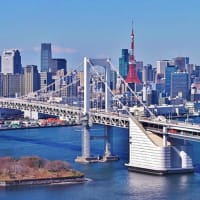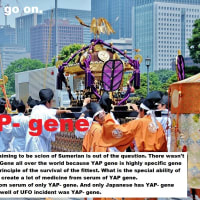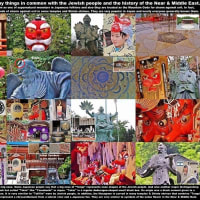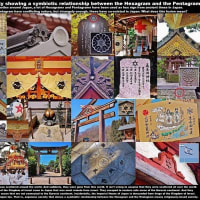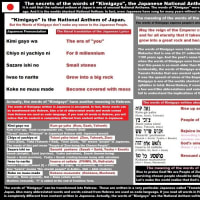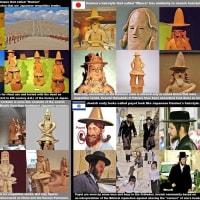Roots of the Emperor of Japan & the Imperial House of Japan are scion of Sumerian King. D2 gene=YAP.
2012 Roots of the Emperor of Japan and the Imperial House of Japan.
Japan's emperor and Japanese have a lot of Secret. Do you know real Roots of ancient Japan? Actually, Japan, in origin, is from Sumerian civilization. And the Japanese emperor have originated as Sumerian king. Why Japnese is ancient israelites (real jewish)? Why Japanese is Sumerian? I'll tell you hidden history of the Japanese emperor that only Japanese and world's upper class know.
Secret of D2 (+YAP gene & -YAP gene).
D2 gene Japanese (Japanese 42%, Ainu 88%, okinawa 60%,55 million people), Chinese 0%, Korean 0%.
YAP gene Japanese (Yes), Chinese (No), Korean (No)
-YAP gene Only Japanese has this gene in the world.
This is the ultimate difference between Japanese and Chinese (Korean=Chinese). Actually, Japan is completely unrelated to East Asia. Japanese ≒ Hebrews. And in this world only japanese has the same -YAP gean as Roswell. And japanese has GOD gene (+YAP GEAN & -YAP GEAN). Why?
Japanese Y chromosome, size of Japanese chromosome, Imperial Seal of Japan, Government Seal of Japan,
Kimigayo (the national anthem of Japan), Kofun (Japanese Imperial tomb), festivalm, Japanese word etc...
Japan is a country with a big secret. I'll tell you about that things.
Chinese & Korean never hold a candle to Japanese. Japanese never be in with Chinese & Korean. Chinese and Korean don't feel jealous of Japanese who come of a God's line. Let's face facts.
” Roots of the Emperor of Japan & the Imperial House of Japan are scion of Sumerian King. D2 gene = YAP gean. ”
Where is the origin of Japanese?
In this world, Only Japanese has the same -YAP gene as Roswell !?
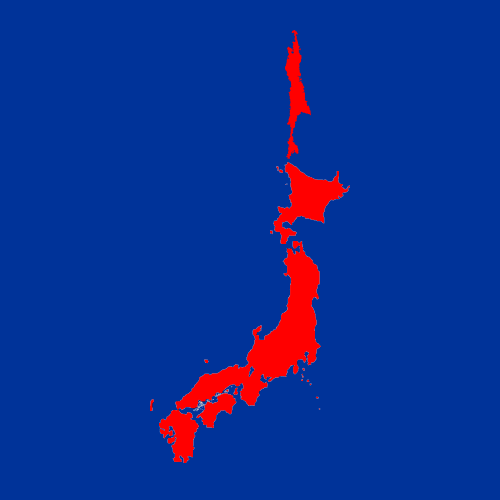
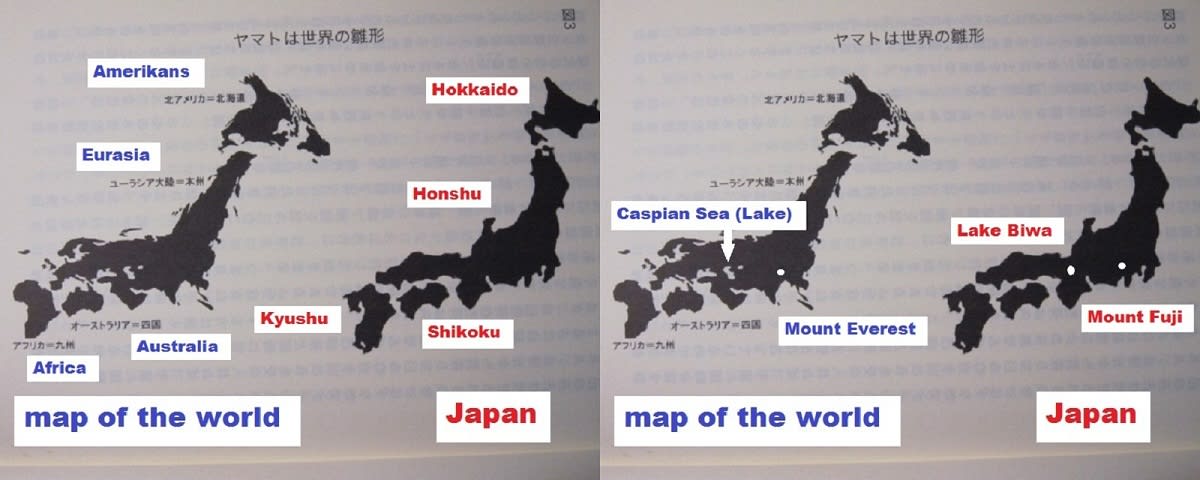
The Imperial Seal of Japan.
The symbol is a yellow or orange chrysanthemum with black or red outlines and background. A central disc is surrounded by a front set of 16 petals. A rear set of 16 petals are half staggered in relation to the front set and are visible at the edges of the flower. An example of the chrysanthemum being used is in the badge for theOrder of the Chrysanthemum.

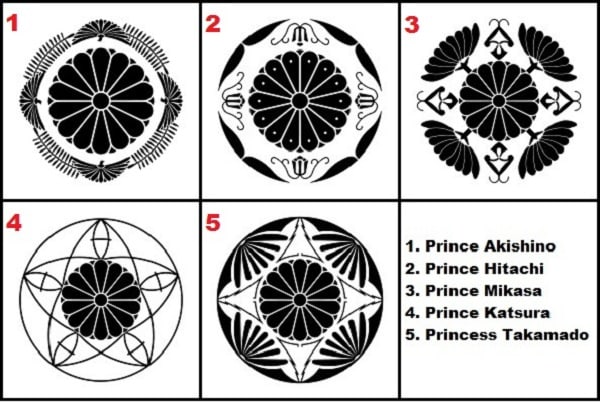
Kamon in Japan.

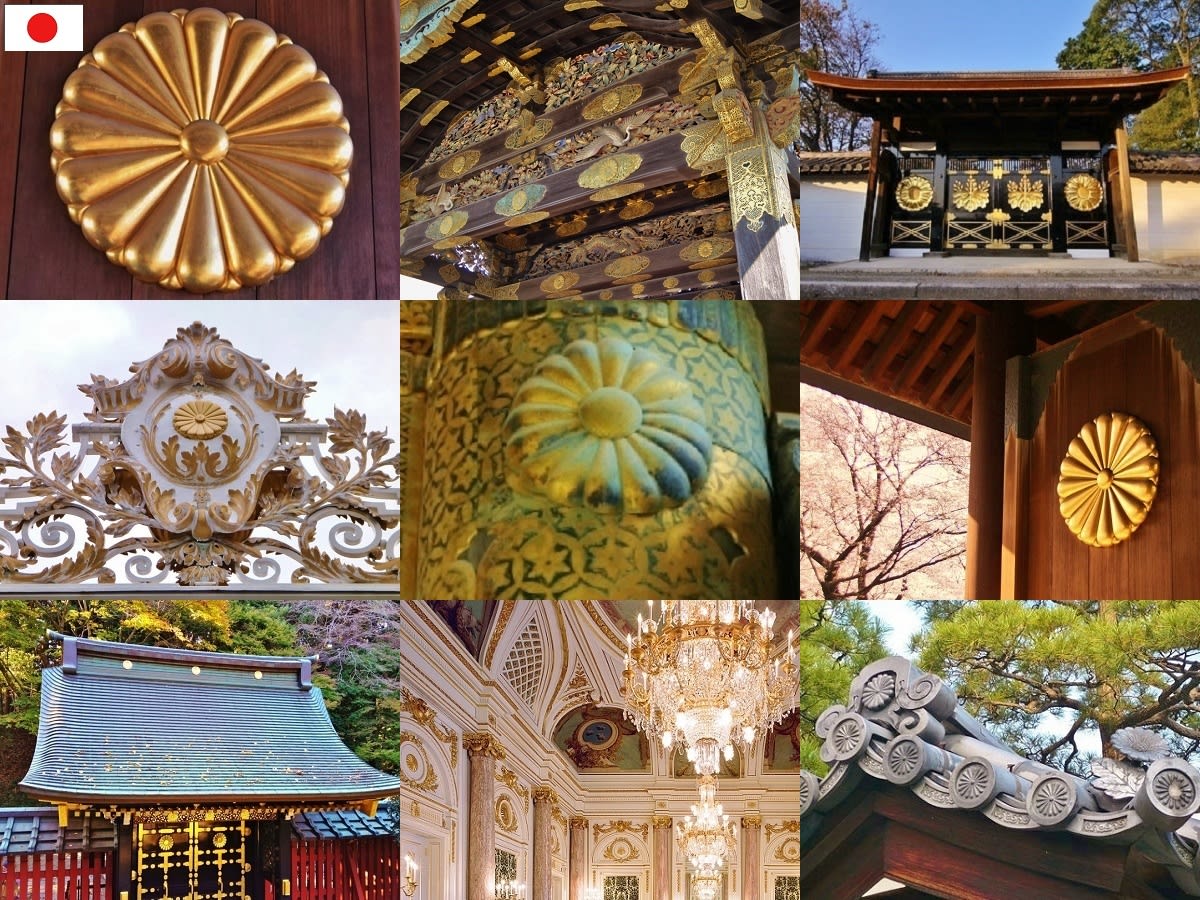

The royal coat of arms dominated the world.

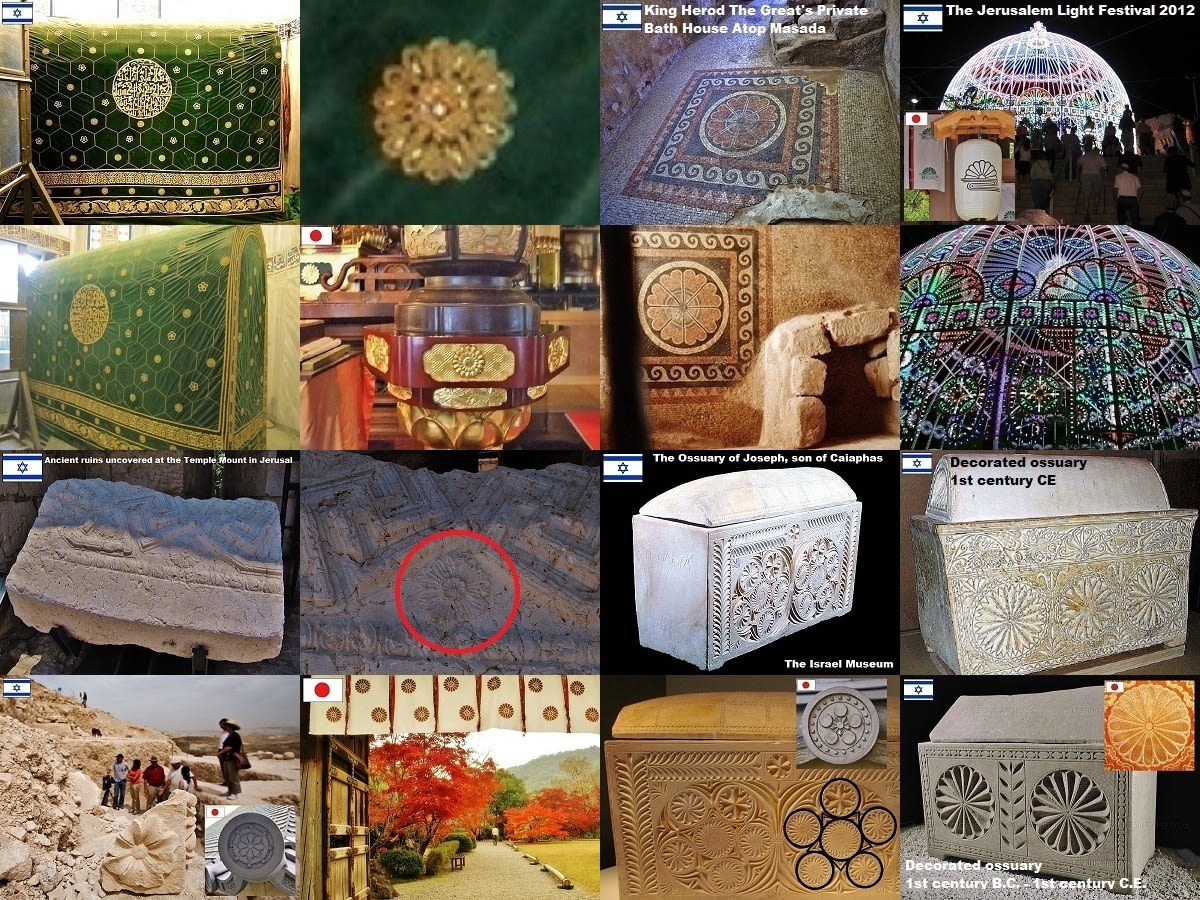


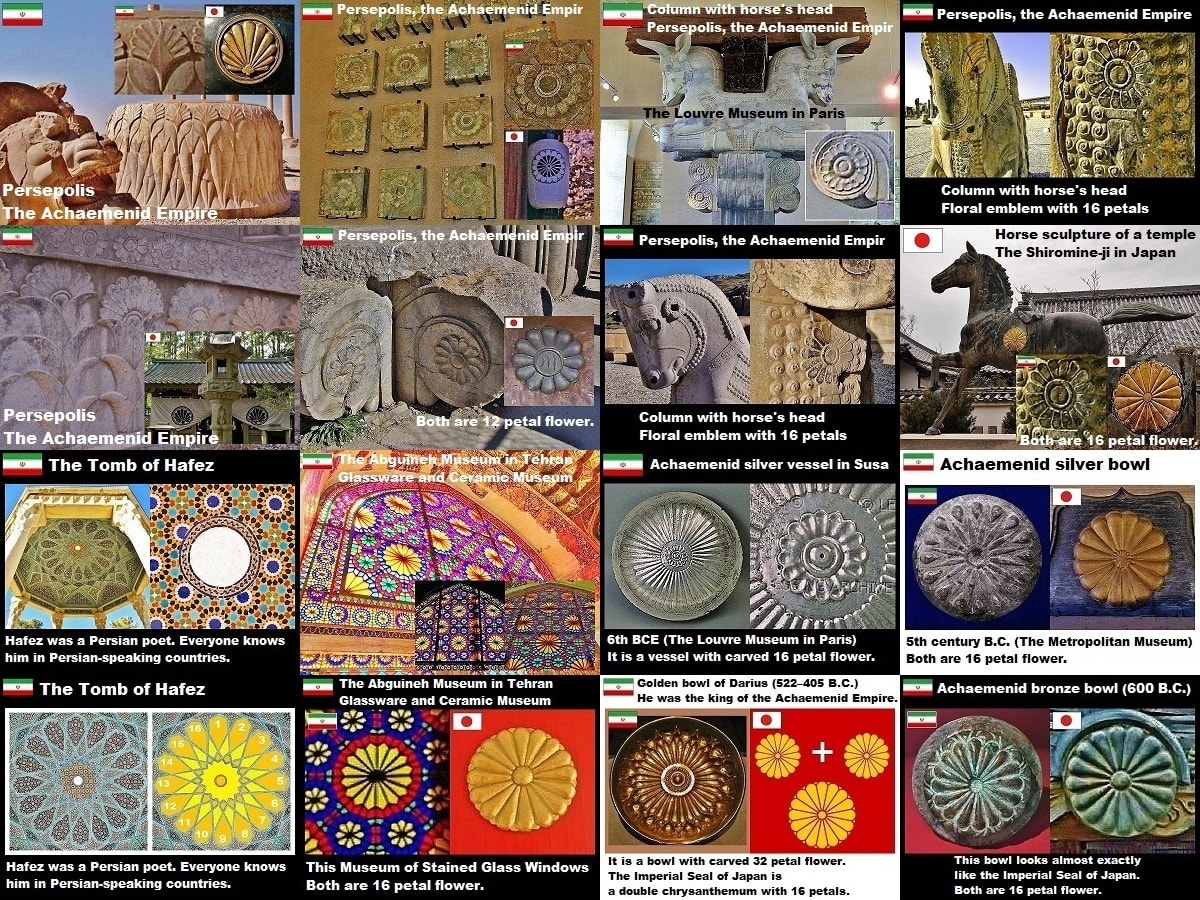

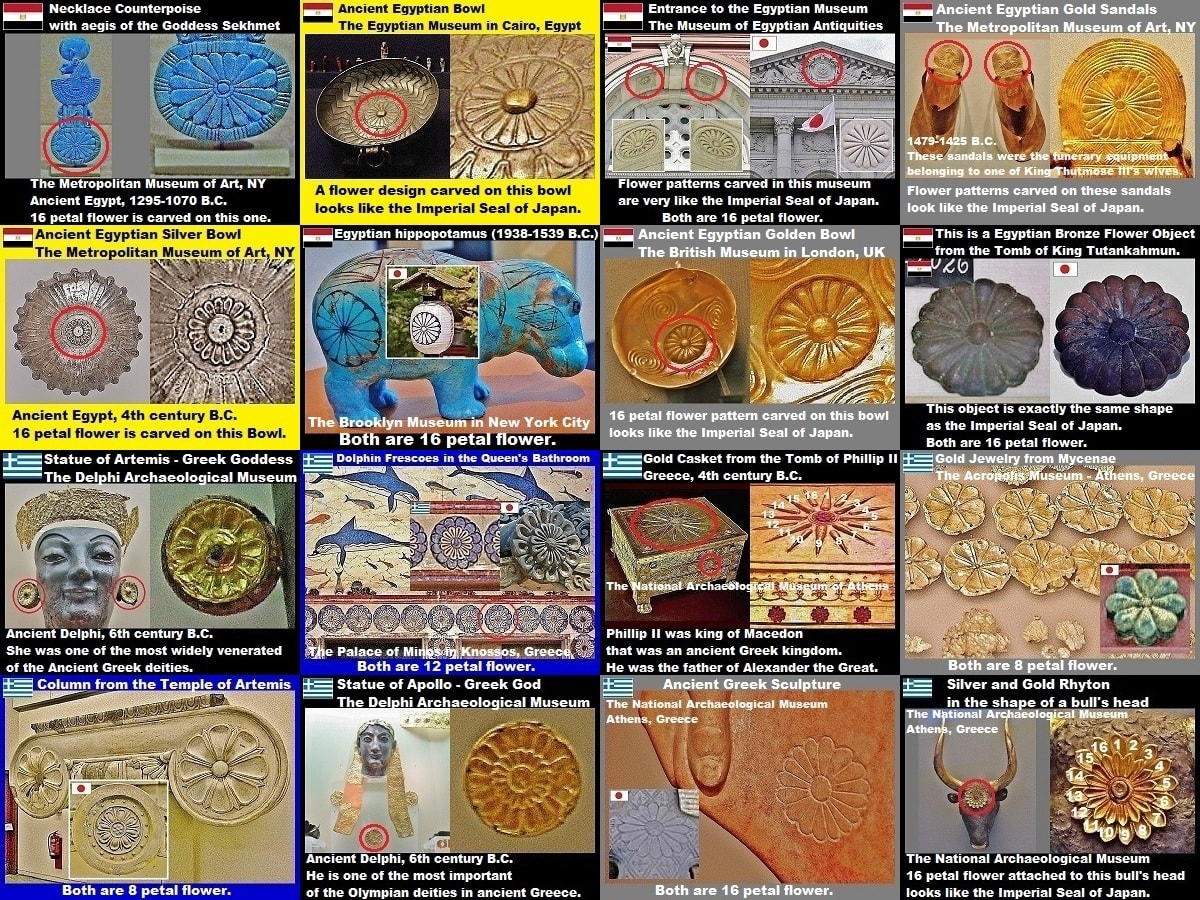

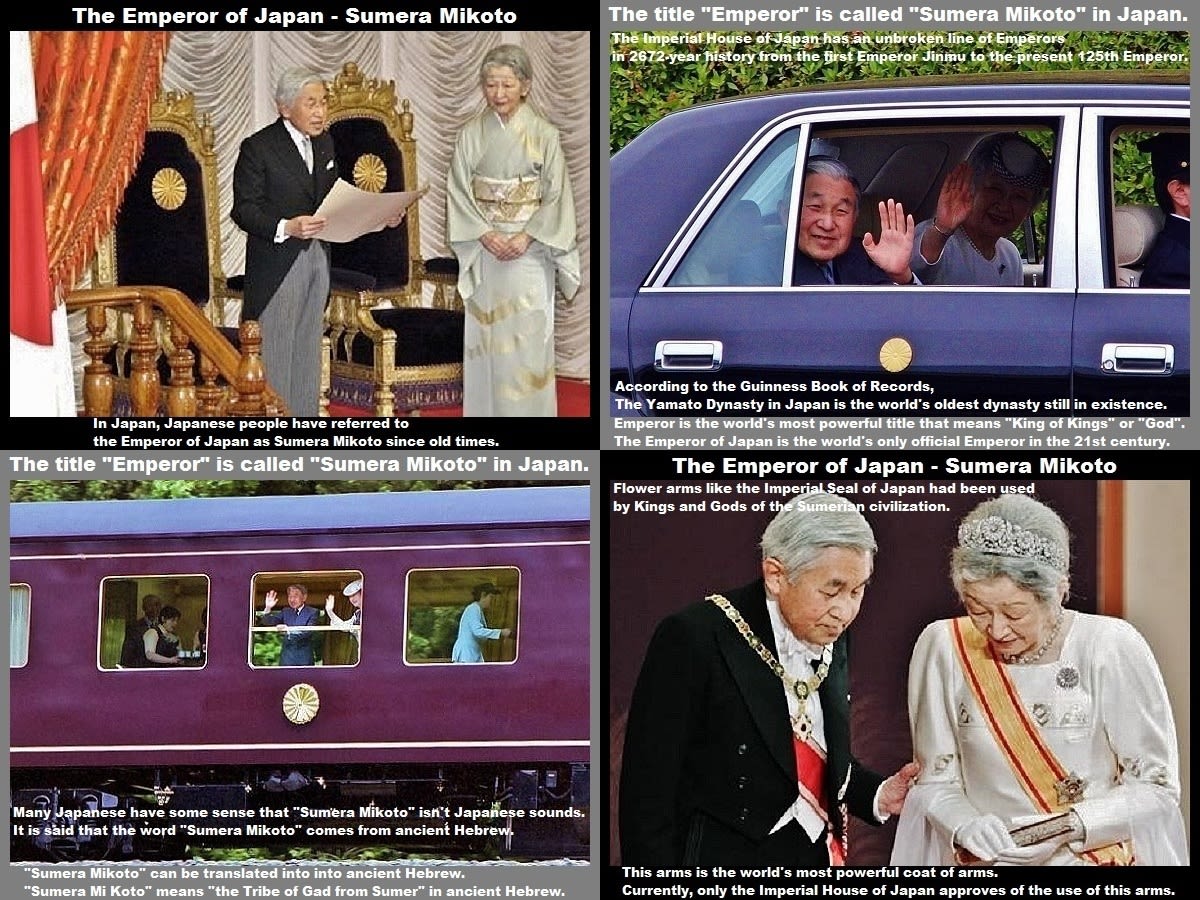 Emperor is the world's most powerful title that means "King of Kings" or "God". And the Emperor of Japan is the world's only official Emperor in the 21st century. In addition, the Imperial House of Japan has an unbroken line of Emperors in 2672-year history from the first Emperor Jinmu right through to the present 125th Emperor, Akihito. According to the Guinness Book of Records, The Yamato Dynasty in Japan is the world's oldest dynasty still in existence. In Japan, Japanese people have referred to the Emperor of Japan as Sumera Mikoto since old times. But many Japanese have some sense that "Sumera Mikoto" isn't Japanese sounds. And it is said that the word "Sumera Mikoto" comes from ancient Hebrew. Actually, "Sumera Mi Koto" means "the Tribe of Gad from Sumer" in ancient Hebrew.
Emperor is the world's most powerful title that means "King of Kings" or "God". And the Emperor of Japan is the world's only official Emperor in the 21st century. In addition, the Imperial House of Japan has an unbroken line of Emperors in 2672-year history from the first Emperor Jinmu right through to the present 125th Emperor, Akihito. According to the Guinness Book of Records, The Yamato Dynasty in Japan is the world's oldest dynasty still in existence. In Japan, Japanese people have referred to the Emperor of Japan as Sumera Mikoto since old times. But many Japanese have some sense that "Sumera Mikoto" isn't Japanese sounds. And it is said that the word "Sumera Mikoto" comes from ancient Hebrew. Actually, "Sumera Mi Koto" means "the Tribe of Gad from Sumer" in ancient Hebrew.
Flower arms like the Imperial Seal of Japan had been used by Kings and Gods of the Sumerian civilization. In other words, this arms that had been used in the Sumerian civilization is the world's most powerful coat of arms. Currently, only the Imperial House of Japan officially approves of the use of this arms.
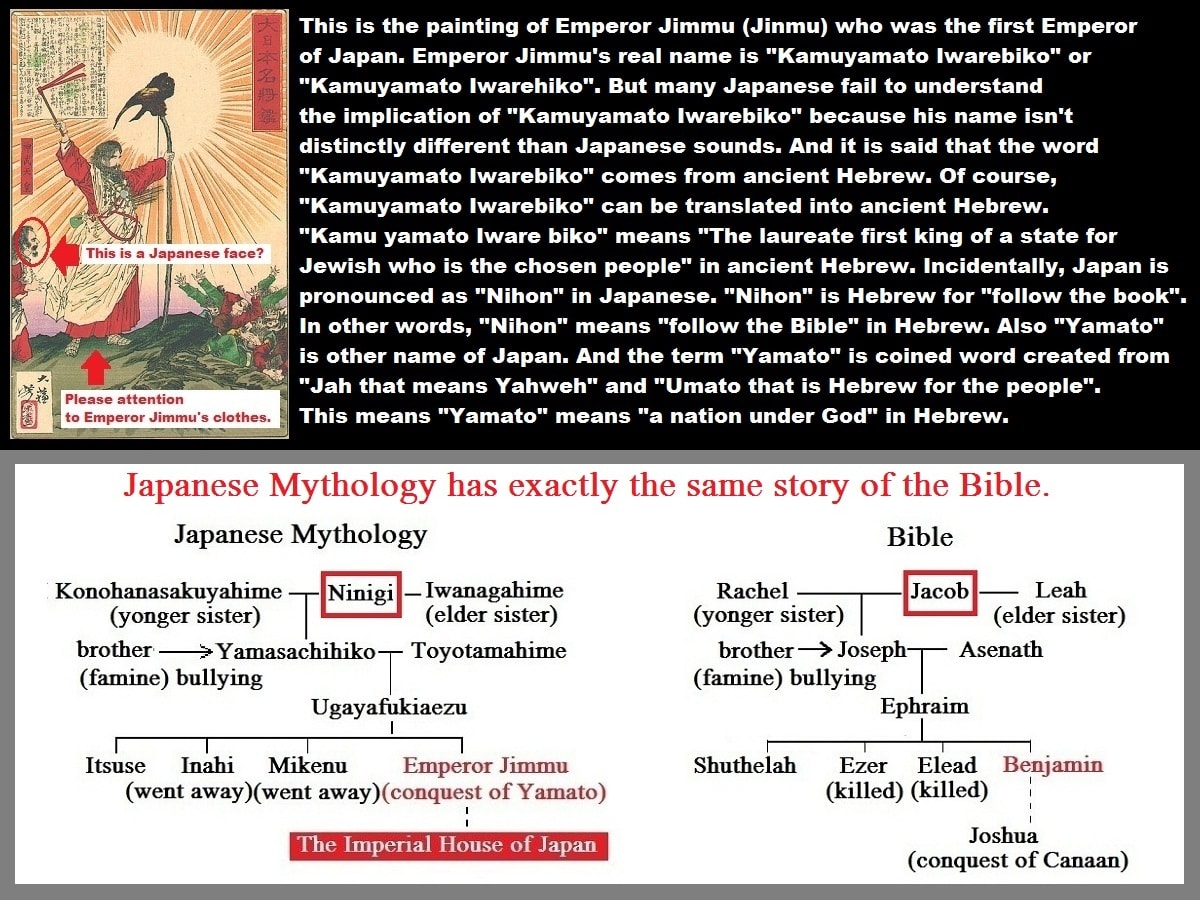 This is the painting of Emperor Jimmu (Jinmu) who was the first Emperor of Japan. Emperor Jimmu's real name is "Kamuyamato Iwarebiko" or "Kamuyamato Iwarehiko" But many Japanese fail to understand the implication of "Kamuyamato Iwarebiko" because his name isn't distinctly different than Japanese sounds. And it is said that the word "Kamuyamato Iwarebiko" comes from ancient Hebrew. Of course, "Kamuyamato Iwarebiko" can be translated into ancient Hebrew. "Kamu yamato Iware biko" means "The laureate first king of a state for Jewish who is the chosen people" in ancient Hebrew. Incidentally, Japan is pronounced as "Nihon" in Japanese. "Nihon" is Hebrew for "follow the book". In other words, "Nihon" means "follow the Bible" in Hebrew. Also "Yamato" is other name of Japan. And the term "Yamato" is coined word created from "Jah that means Yahweh" and "Umato that is Hebrew for the people". This means "Yamato" means "a nation under God" in Hebrew.
This is the painting of Emperor Jimmu (Jinmu) who was the first Emperor of Japan. Emperor Jimmu's real name is "Kamuyamato Iwarebiko" or "Kamuyamato Iwarehiko" But many Japanese fail to understand the implication of "Kamuyamato Iwarebiko" because his name isn't distinctly different than Japanese sounds. And it is said that the word "Kamuyamato Iwarebiko" comes from ancient Hebrew. Of course, "Kamuyamato Iwarebiko" can be translated into ancient Hebrew. "Kamu yamato Iware biko" means "The laureate first king of a state for Jewish who is the chosen people" in ancient Hebrew. Incidentally, Japan is pronounced as "Nihon" in Japanese. "Nihon" is Hebrew for "follow the book". In other words, "Nihon" means "follow the Bible" in Hebrew. Also "Yamato" is other name of Japan. And the term "Yamato" is coined word created from "Jah that means Yahweh" and "Umato that is Hebrew for the people". This means "Yamato" means "a nation under God" in Hebrew.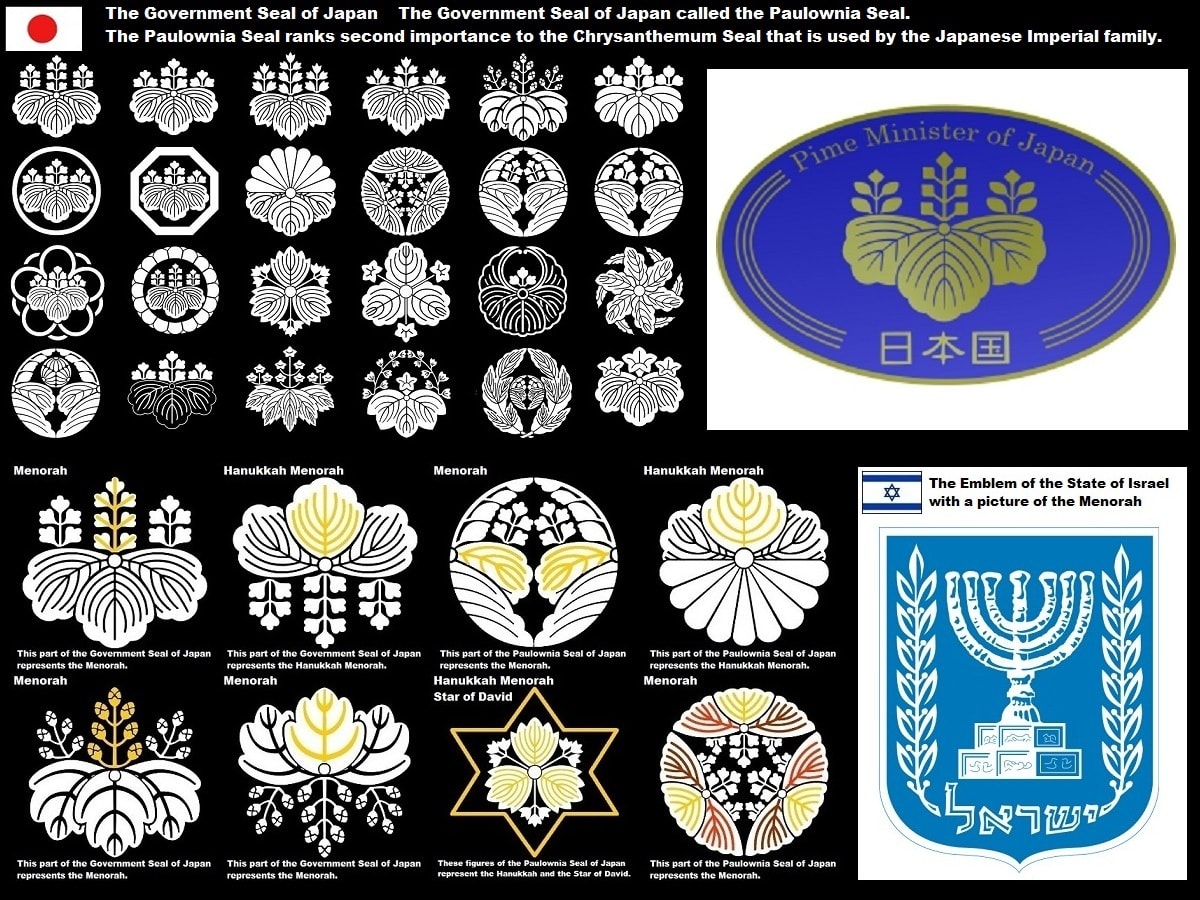
 The Government Seal of Japan called the Paulownia Seal. The Paulownia Seal ranks the most second importance to the Chrysanthemum Seal that is used by members of the Japanese Imperial family. In ancient times, the Paulownia Seal was used by members of the Japanese Imperial family and families of nobility, a feudal lord who served in the Emperor of Japan. In Japan, the Paulownia Seal are rumoured to have dark secrets. Actually, it is said that the Paulownia Seal represents the Menorah and the Hanukkah Menorah that is described in the Bible. Also the Star of David is hidden in some types of the Paulownia Seal.
The Government Seal of Japan called the Paulownia Seal. The Paulownia Seal ranks the most second importance to the Chrysanthemum Seal that is used by members of the Japanese Imperial family. In ancient times, the Paulownia Seal was used by members of the Japanese Imperial family and families of nobility, a feudal lord who served in the Emperor of Japan. In Japan, the Paulownia Seal are rumoured to have dark secrets. Actually, it is said that the Paulownia Seal represents the Menorah and the Hanukkah Menorah that is described in the Bible. Also the Star of David is hidden in some types of the Paulownia Seal.
 "Shugendo" is mystical-spiritual tradition which originated in Japan. And "Yamabushi" is a Practitioner of "Shugendo" who enters mountains to undergo training there. Chinese and Koreans never have practices like Japanese "Yamabushi". And also in Japan it is said that Japanese "Yamabushi" and Jewish "Tefillin" have a lot in common. There are in the world today more than 3000 of different races. But the only Jewish "Tefillin" is very similar to Japanese "Yamabushi" on Earth. There is little mention of similarities between Japanese "Yamabushi" and Jewish "Tefillin" written in English because Japanese doesn't want many of that similarity widely known.
"Shugendo" is mystical-spiritual tradition which originated in Japan. And "Yamabushi" is a Practitioner of "Shugendo" who enters mountains to undergo training there. Chinese and Koreans never have practices like Japanese "Yamabushi". And also in Japan it is said that Japanese "Yamabushi" and Jewish "Tefillin" have a lot in common. There are in the world today more than 3000 of different races. But the only Jewish "Tefillin" is very similar to Japanese "Yamabushi" on Earth. There is little mention of similarities between Japanese "Yamabushi" and Jewish "Tefillin" written in English because Japanese doesn't want many of that similarity widely known.

The Imperial Regalia of Japan means three sacred Imperial treasures that consist of Kusanagi-no-Tsurugi, Yata-no-Kagami and Yasakani no Magatama. Kusanagi-no-Tsurugi is a legendary Japanese sword. Yata-no-Kagami is a sacred mirror that is part of the Imperial Regalia of Japan. Yasakani-no-Magatama is beady jewel. The Imperial Regalia of Japan is being kept under cover as deities. Basically, even the Emperor of Japan can't see Imperial treasures. But the real reason that everybody have never been seen these treasures is because letters that are engraved on the reverse side of the Yata-no-Kagami that aren't Japanese characters. Some letters are carved on the reverse side of the Yata-no-Kagami. But Japan’s emperor at that time couldn't decode those groups of words like ancient Hebrew characters. So about 130 years ago, the Japanese government asked Arinori Mori, then Education Minister, to examine it. Arinori Mori secretly saw Yata-no-Kagami that nobody couldn't see. And he copied letters carved on it. This illustration on the left is a figure that was transcribed by him. And It is said that many Hebraist is secretly carrying out research on it. But even they become extremely hard to take those letters. In addition, there are doubts about an exact copy, because Arinori mori took copied those letters by hand on paper. Also these characters are encrypted. So interpretation of those characters is great difficulty. But among these, sentence meaning gradually becomes clear. It is said that the Yata-no-Kagami have words like "David” and "I am that I am". "I am that I am" is a common English translation of the response God used in the Hebrew Bible. It is one of the most famous verses in the Torah.


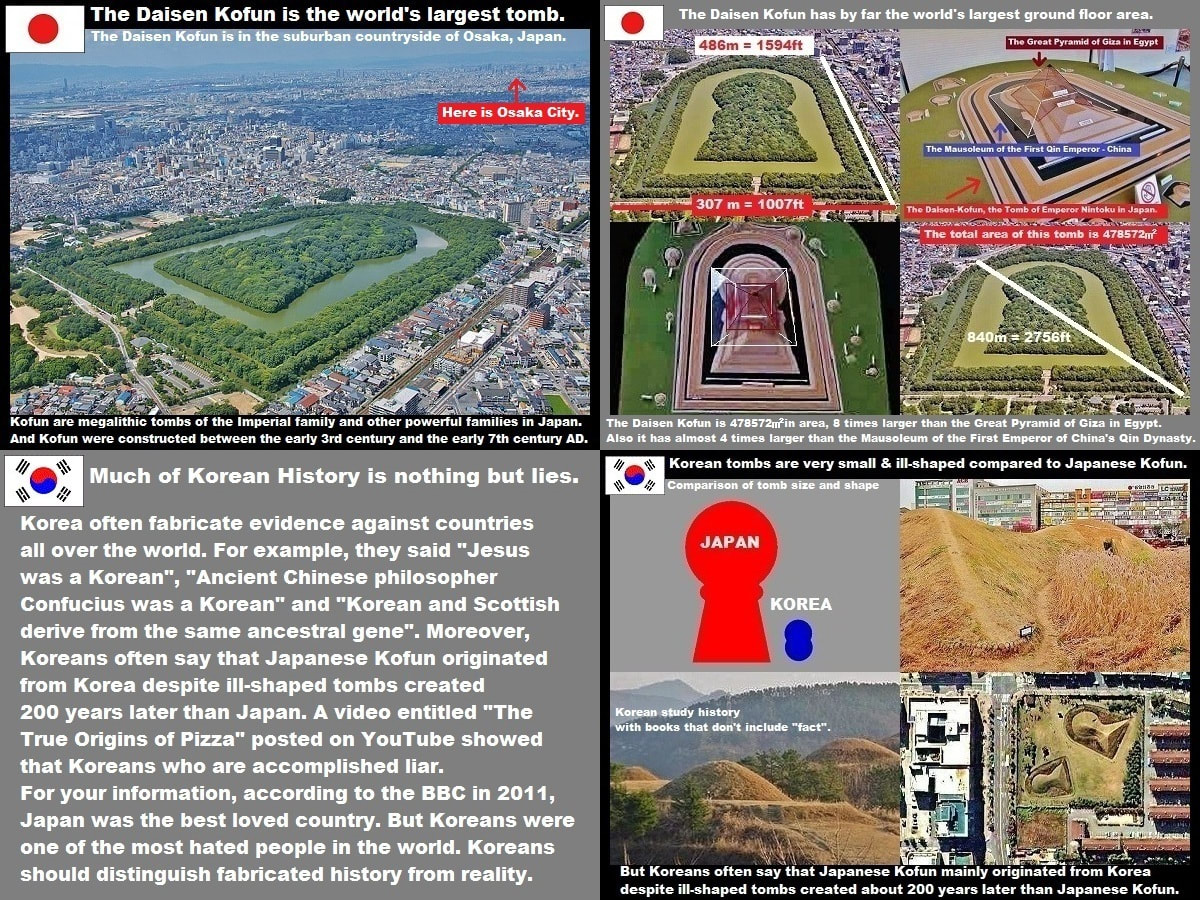
 The Daisen-Kofun has by far the world's largest ground-floor area. This tomb is 478572㎡ in area, about 8 times larger than the Great Pyramid of Giza in Egypt. Also it has almost 4 times more larger than the Mausoleum of the First Emperor of China's Qin Dynasty. And the top two Kofun tombs in Japan are the world's two largest tombs. Today, there are a total of 161,560 Kofun in Japan.
The Daisen-Kofun has by far the world's largest ground-floor area. This tomb is 478572㎡ in area, about 8 times larger than the Great Pyramid of Giza in Egypt. Also it has almost 4 times more larger than the Mausoleum of the First Emperor of China's Qin Dynasty. And the top two Kofun tombs in Japan are the world's two largest tombs. Today, there are a total of 161,560 Kofun in Japan.Korean children study history with books that don't include "fact". And Korea often fabricate evidence against countries all over the world. For example, they said "Jesus was a Korean", "Ancient Chinese philosophr Confucius was a Korean" and "Korean and Scottish derive from the same ancestral gene". Moreover, Koreans often say that Japanese Kofun originated from Korean tombs despite ill-shaped tombs created 200 years later than Japanese tombs. A video entitled "The True Origins of Pizza" posted on YouTube showed that Koreans who are accomplished liar. Korean are too crazy. For your information, according to the BBC in 2011, Japan was the best loved country. But Koreans were one of the most hated people in the world. Koreans should distinguish fabricated history from reality.
The Daisen Kofun is the world's largest tomb. Nevertheless, this Kofun has not been appointed as a World Heritage site. Also it isn't actively promoted as a tourist destination. On the contrary, this Kofun is cordoned off from the public. Actually, the Imperial House and the Imperial Household Agency of Japan oppose adding Kofun to the list of world heritage site. The reason is because commercialization of Kofun leads to unscrupulous behavior. But the real reason is because they don't want someone to go in Kofun and study the remains of the Imperial Family. In addition, the trouble is that shapes of many Kofun look like a jar. Many Japanese think that Kofun represents the shape of the jar of manna placed with the Ark of the Covenant. And in Japan, It is said that the Daisen Kofun which is the the world's largest tomb has a big secret like Yata-no-Kagami which is part of the Imperial Regalia of Japan.


 ★Japan showing a symbiotic relationship between the Hexagram and the Pentagram★
★Japan showing a symbiotic relationship between the Hexagram and the Pentagram★At shrines, temples and castles around Japan, a lot of Hexagrams and Pentagrams have been used as hex sign from ancient times in Japan. The Hexagram and the Pentagram have conflicting nature, but strangely enough, these have co-existed in Japan. What does this fusion mean? It is said that the Ten Lost Tribes of Israel was scattered around the world. And suddenly, they were gone from this world. It isn't wrong to assume that they were scattered all over the world. But most of them including the royal house of the Kingdom of Israel came to Japan that was most remote from israel. They escaped to eastern safe areas of the Eurasia continent. And they reached easternmost Japan islands surrounded by ocean that aren't connected to the Eurasia continent. Incidentally, the Imperial House of Japan is descended from kings of the Kingdom of Israel. Also the people in Arab countries came to Japan too. That is, Japanese society that shows a symbiotic relationship between the Hexagram and the Pentagram means religiously-mixed society.
 In Japan, "Tengu" are known as one of supernatural monsters in Japanese folklore and also they are treated as the Mountain Gods for charm against evil. In fact, "Tengu" are enshrined as Gods of charm against evil in some temples and Shinto shrines. They are very popular in Japan and nearly everyone generally knows them.
In Japan, "Tengu" are known as one of supernatural monsters in Japanese folklore and also they are treated as the Mountain Gods for charm against evil. In fact, "Tengu" are enshrined as Gods of charm against evil in some temples and Shinto shrines. They are very popular in Japan and nearly everyone generally knows them.
The most distinctive feature of "Tengu" is a big nose. Some Japanese people say that a big nose of "Tengu" represents nose shapes of the Jewish people. And also another major distinguishing feature is that they always wear a small black hat called "Tokin" like "Yamabushi" in Japan. "Tokin" is a regular dodecagon-shaped small black box. Its origin was a black coronet given to a Japanese holy man from the Emperor of Japan. It is very similiar to "Tefillin" worn by Jewish people. In addition, the Hexagram is carved in many temples & Shinto shrines that enshrine "Tengu" as Gods. Meanwhile, most of their symbols represent a chrysanthemum from a lateral view and a Japanese fan. And also they are very similar to symbols of the Lotus flower in the Near & Middle East. That means that Tengu also have many things in common with the Jewish people and the history of the Near and Middle East.
 A torii is a Shinto shrine gate that consists of two upright pillars connected by two horizontal beams on top. In the past, Chinese & Koreans archaeologists attempted to associate their history with torii. But the origins of the torii are unknown. And also Japanese people often said that the origin of Torii goes back to the ancient Israelites. Actually, Japanese people follow the principles of the Book of Exodus in the Old Testament.
A torii is a Shinto shrine gate that consists of two upright pillars connected by two horizontal beams on top. In the past, Chinese & Koreans archaeologists attempted to associate their history with torii. But the origins of the torii are unknown. And also Japanese people often said that the origin of Torii goes back to the ancient Israelites. Actually, Japanese people follow the principles of the Book of Exodus in the Old Testament.
In Japan, it is said that a torii comes from the customs of the ancient Israelites. To prove it, a Torii of red paint is similar to a ceremony of Judaism that is called Passover. And the Bible says, "Moses told his companions what to paint the cross bar & two upright pillars of the front door in red by the blood of lambs". In addition, the shape of a torii represents the two pillars of solomon's temple. Also the religious affiliation of the Japanese Imperial family isn't Buddhism or Confucianism but Shinto that respects Amaterasu. Torii are closely related the Imperial family that is the only one in the world. In short, Japanese people still have secretly followed the principles of the Old Testament - Exodus. But the Imperial Household Agency pointedly has avoided any mention of it.
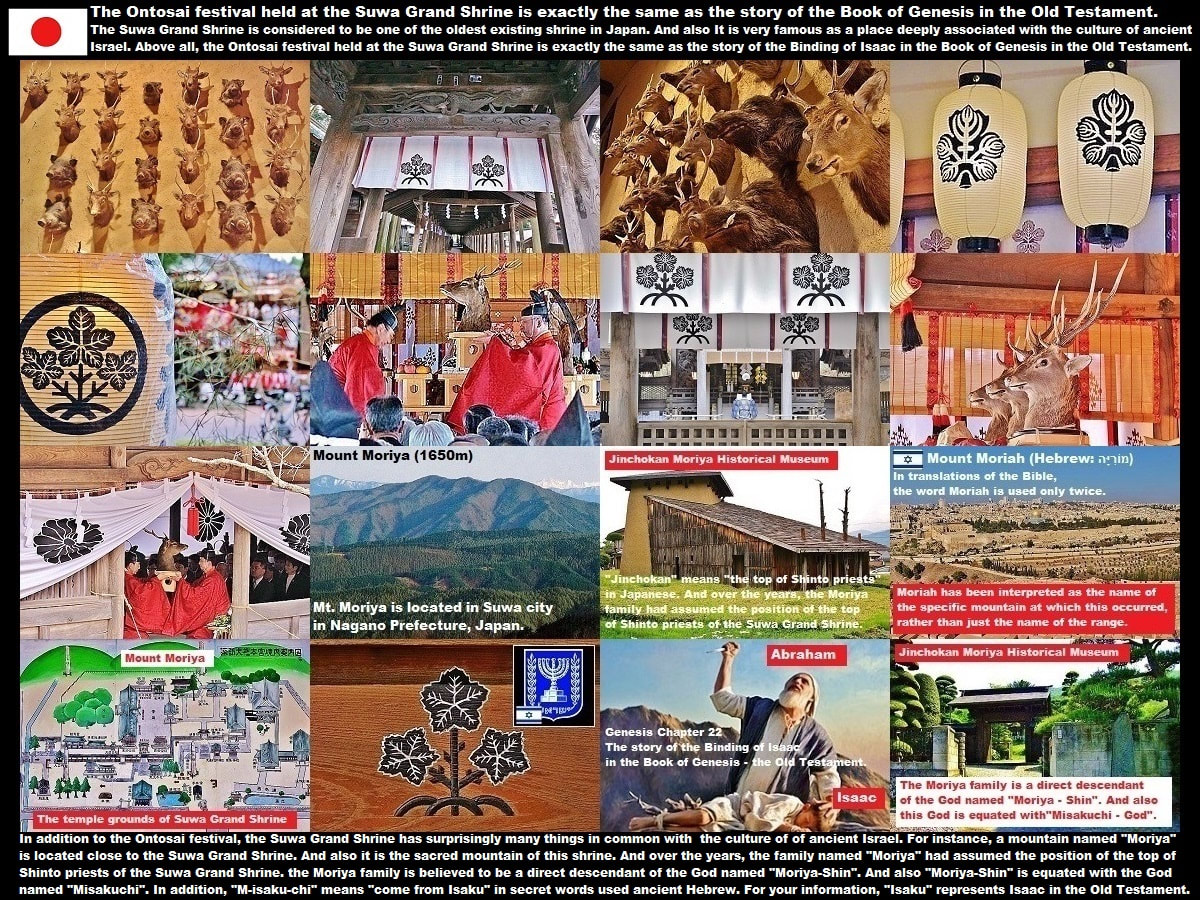 The Suwa Grand Shrine is considered to be one of the oldest existing shrine in Japan. And It is also famous as a place deeply associated with the culture of ancient Israel. Above all, the Ontosai festival held at the Suwa Grand Shrine is exactly the same as the story of the Binding of Isaac in the Book of Genesis in the Old Testament, it's garnered quite a bit of attention from many Japanese people. In addition to the Ontosai festival, the Suwa Grand Shrine has surprisingly many things in common with the culture of of ancient Israel. For instance, a mountain named "Moriya" is located close to the Suwa Grand Shrine. And also it is the sacred mountain of this shrine. And over the years, the family named "Moriya" had assumed the position of the top of Shinto priests of the Suwa Grand Shrine. the Moriya family is believed to be a direct descendant of the God named "Moriya-Shin". And also "Moriya-Shin" is equated with the God named "Misakuchi". In addition, "M-isaku-chi" means "come from Isaku" in secret words used ancient Hebrew. For your information, "Isaku" represents Isaac in the Old Testament.
The Suwa Grand Shrine is considered to be one of the oldest existing shrine in Japan. And It is also famous as a place deeply associated with the culture of ancient Israel. Above all, the Ontosai festival held at the Suwa Grand Shrine is exactly the same as the story of the Binding of Isaac in the Book of Genesis in the Old Testament, it's garnered quite a bit of attention from many Japanese people. In addition to the Ontosai festival, the Suwa Grand Shrine has surprisingly many things in common with the culture of of ancient Israel. For instance, a mountain named "Moriya" is located close to the Suwa Grand Shrine. And also it is the sacred mountain of this shrine. And over the years, the family named "Moriya" had assumed the position of the top of Shinto priests of the Suwa Grand Shrine. the Moriya family is believed to be a direct descendant of the God named "Moriya-Shin". And also "Moriya-Shin" is equated with the God named "Misakuchi". In addition, "M-isaku-chi" means "come from Isaku" in secret words used ancient Hebrew. For your information, "Isaku" represents Isaac in the Old Testament.



This was just the beginning. Sumeramikoto story (The Emperor of Japan's real name) will soon be appearing in this blog.










